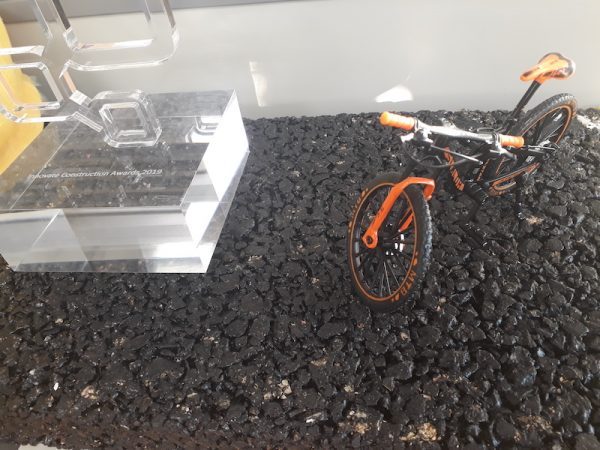
Asphalt 4.0, which sometimes goes hand in hand with highways 4.0, is a relatively new concept that encompasses a series of design and construction techniques based on technology and digitization. Its objective is to improve the road surface’s performance and durability, thus reducing maintenance costs and improving the road’s sustainability conditions.
This way of working is not very common yet. It’s based on a sort of circular innovation that uses data from the entire construction process in order to find new materials and techniques that can help build better roads. This is how highway testing and construction are being digitized.
What is asphalt 4.0?
Despite what it might sound like, asphalt 4.0 is not a type of pavement. It’s a way of studying, designing, building, and maintaining this infrastructure at lower costs over the road’s entire life. This approach also aims to decrease construction’s environmental impact. It’s like a good recipe that also helps us find better ingredients through data and innovation.
According to issue 34 of Asfalto y pavimentación magazine, “the digital transformation of paving highways, asphalt 4.0, is the automation, sensorization, data capture, and improvement of conventional management, manufacturing, supply, commissioning activities, on-site work, etc… using digital technology to improve the way the organization carries out its work. This way, it also helps those working on it.”
 Image | Jose Javier Garcia Pardenilla
Image | Jose Javier Garcia Pardenilla
Asphalt 4.0 is the application of the fourth industrial revolution to road construction. However, asphalt 4.0 should not be confused with highways 4.0. The latter also includes other elements like signage and vehicle loading. In the distant future, it will also include energy generation and roads that can repair themselves in the distant future.
As expert infrastructure reporter Javier R. Ventosa writes in ‘What the road infrastructure of the future will be like: highways 4.0,’ for Revista del Ministerio de Fomento (the Ministry of Development’s journal) “the highways of the future are increasingly defined by their main feature: the road surface.” The asphalt is its most important element.
What makes asphalt 4.0 different?
What sets asphalt 4.0 apart is monitoring and digitizing all of the factors that affect the quality of execution. This is how BIM (Building Information Modeling) is characterized by monitoring and digitizing all of the elements of a building’s construction.
Asphalt being manufactured and laid during highway construction involves several key variables. These include the material’s composition; the time needed for transporting, spreading, and compacting the asphalt; the number of passes made with the compactor to reach a certain density, and meteorological conditions such as temperature, wind, and humidity.
High-quality work requires manufacturing, transporting, spreading, and compacting at the right temperatures. This includes wind-dependent factors, such as the heat transfer coefficient. For example, if a certain type of asphalt is designed to be spread above 10ºC, a day with temperatures at 10ºC but with winds of 30 km/h may not be ideal. However, a 5ºC day with 5 km/h winds may be.
How this way of building highways is used today
 Image | Jose Javier Garcia Pardenilla
Image | Jose Javier Garcia Pardenilla
The creation of any type of asphalt and its specific manufacturing, transportation, paving, and compaction needs are first seen in a laboratory. This is where historical data and knowledge are used to design new compounds that improve highway performance.
The lab is where new materials are tested and their behavior is analyzed based on heat, friction, humidity, saltpeter, the passage of time under certain conditions, and more factors. This is also where the optimal conditions are designed for carrying out the work; they will then have to be measured.
Once a new type of asphalt is created with all of the digitized data about its characteristics (granulometric composition, density, resistance, elasticity, etc.), construction is carried out while striving to recreate ideal conditions as closely as possible. Once again, it is important to monitor the entire process: the position and origin of each ton of material, the temperature at which it is spread, the GPS position of compactors, and so on.
Compacting to the design’s density is key to ensuring good durability and approximating the desired pavement characteristics. This is why this parameter is also measured and digitized all along the highway. At the end of the project, the digital fingerprint documents how the entire highway was built, meter by meter. But what is all of this good for?
Staying ahead of future problems by using data
 Image | Jose Javier Garcia Pardenilla
Image | Jose Javier Garcia Pardenilla
Digitizing the entire highway provides information on how closely the pavement fits the design conditions. This facilitates locating future problems with the pavement, such as accelerated erosion. The digital makes it easy to find out the density at which each kilometer was compacted or where it rained a few hours after spreading.
With all this information, we can build a body of knowledge that will help detect where deterioration is most likely to begin within a few years. This helps optimize maintenance. It also helps us get ahead of what the future has in store. Digital data from construction and the data collected each year about the highway’s status leads us to discover new ways of working.
The key to asphalt 4.0 is this circular innovation procedure. Data on the behavior of a certain type of asphalt built in a specific way can lead to research that will discover new materials and better ways of doing that construction.






There are no comments yet